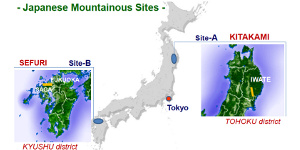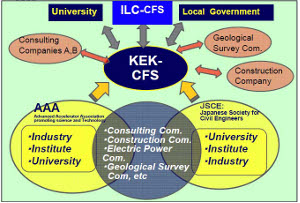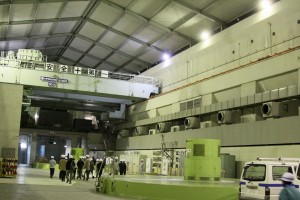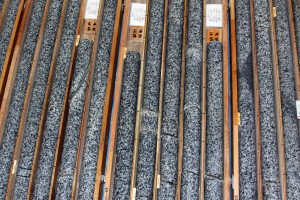
Locations of the two candidate Japanese sites: a northern site in the Tohoku district and a southern site in the Kyushu district
A common question I am often asked is where the ILC will be sited. That is obviously a very important question, but we don’t have an answer yet. We will complete the Technical Design Report (TDR) within the next year and the Large Hadron Collider will, we believe, produce physics results that can both motivate the ILC project and help guide the final parameters. Also this year, the International Linear Collider Steering Committee is forming a special committee to give advice on how to approach the siting the ILC. In any case, early interest in hosting the facility is both welcome and very useful in helping to make our TDR even more realistic because we are able to take into account important site-dependent issues.
The developmental work towards Japanese ILC sites began in 2009 by the Advanced Accelerator Association Promoting Science and Technology (AAA). In 2010, the local communities, especially universities for both candidate sites, organised geological studies, including investigations of various tunnel shapes for the mountainous sites. KEK then evaluated the tunnel designs and the environmental conditions presented in these studies.
The next phase of the work on the Japanese sites will be coordinated by the KEK laboratory, which will take care of tunnelling, electrical and mechanical issues, and by the Japanese Civil Engineering Association, which will deal with assessing the geological surveys and civil engineering. This future work will be supported through a supplemental earthquake recovery budget, and it will include support for further site-dependent geological studies at the candidate sites that will be coordinated through KEK, along with the local university and government communities.
The ILC has received considerable recent attention by the government of Japan. The Science and Technology Policy Council of the Cabinet of the Japanese government received a brief report from the Cabinet office and the Japanese funding agency MEXT on 1 September last year on the science objectives of the ILC project and the global status. Then, as we reported in the 19 December 2011 Special Issue of ILC NewsLine, Prime Minister Yoshihiko Noda spoke, and other high-government officials participated in an AAA Symposium in Tokyo.
The two candidate sites are located in mountainous regions where the geology for tunnelling is stable granite rock without active faults or volcanoes. There are good access roads to these candidate sites and high-voltage transmission lines nearby. The local governments and community are supportive and cooperative towards developing these sites for a possible ILC project.
We first visited the southern candidate site located in Fukuoka and Saga prefectures on Kyushu, an island located in the southwestern part of Japan. The actual site is located in the picturesque Sefuri mountain range. Although the exact location and trajectory of the linac is yet to be determined, we were able to view much of the terrain where the linac will be located. The initial 500-GeV machine would be installed in hard low-permeability granite, and schemes proposed for a future extension to 1 TeV appear feasible by incorporating a slight tilt in the linac to go under a river bed into a sandstone-dominated region.
We were able to go underground to visit the Tenzan underground hydraulic power plant near the location of the proposed ILC interaction region. We drove down an inclined road, similar to what is proposed for the ILC, and viewed the geology, excavation techniques and a large cavern that looked similar to the proposed design of the ILC detector hall. In my view, this visit went some way towards demonstrating the feasibility of construction of the ILC at this site.
We then visited the northern candidate Japanese site, which is north of Sendai in Iwate Prefecture in the mountains east of Kitakami Junction. Importantly, “The Great East Japan Earthquake and Tsunami Recovery Plan” that has been developed for this area is based on a “multilayered approach, including urgent, short-term, medium-term and long-term efforts.” The ILC siting and development of a research hub are an integral part of this plan.
We visited the candidate site area, viewed potential access points and reviewed the geology and granite samples from borings where the linac and interaction region may be located. Like the Kyushu candidate site, this site appears to be a viable site for the ILC.
There are a number of options for the exact configurations at each site. Inclined access is proposed from the sides with a roughly 10 percent grade and that appears workable, as we witnessed by visiting the underground power plant near the Kyushu site. There are major universities in the general vicinity of both sites, and general access to advanced technology and other types of infrastructure needed for a major particle physics accelerator laboratory.
After visiting both candidate sites, it is clear that mountain sites have many good features and can provide a realistic and attractive location for the ILC. They are accessible, while at the same time being in undeveloped areas of pretty rolling hills that have very good geology.
The Japan’s interest in investigating these mountainous sites for hosting the ILC is very welcome. They are providing us with very valuable information for adapting the ILC design to specific features of mountain sites, and are helping us to understand better what information we will need to assess candidate ILC sites.





Recent Comments